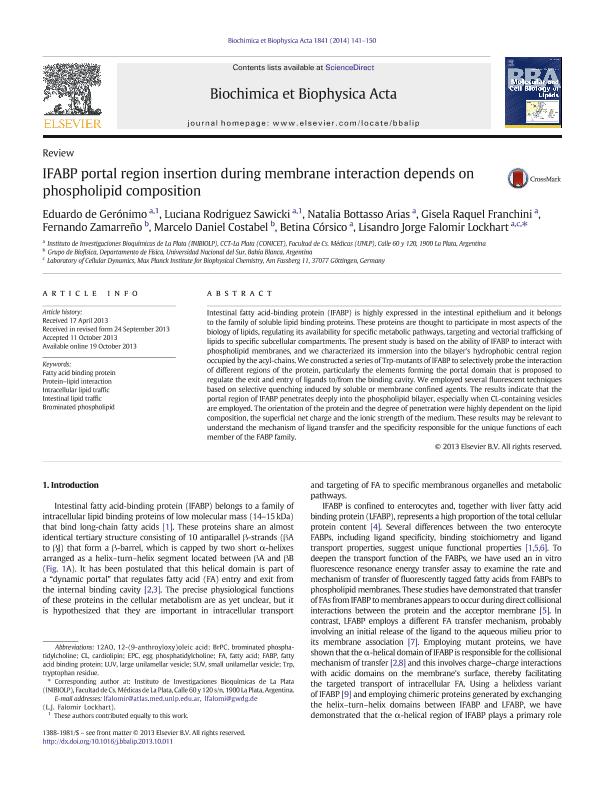Mostrar el registro sencillo del ítem
dc.contributor.author
de Gerónimo, Eduardo

dc.contributor.author
Rodriguez Sawicki, Luciana

dc.contributor.author
Botasso Arias, Natalia
dc.contributor.author
Franchini, Gisela Raquel

dc.contributor.author
Zamarreño, Fernando

dc.contributor.author
Costabel, Marcelo Daniel

dc.contributor.author
Corsico, Betina

dc.contributor.author
Falomir Lockhart, Lisandro Jorge

dc.date.available
2015-09-22T19:43:20Z
dc.date.issued
2014-01
dc.identifier.citation
de Gerónimo, Eduardo; Rodriguez Sawicki, Luciana; Botasso Arias, Natalia; Franchini, Gisela Raquel; Zamarreño, Fernando; et al.; IFABP portal region insertion during membrane interaction depends on phospholipid composition; Elsevier; Biochimica Et Biophysica Acta - Molecular and Cell Biology of Lipids; 1841; 1; 1-2014; 141-150
dc.identifier.issn
1388-1981
dc.identifier.uri
http://hdl.handle.net/11336/2042
dc.description.abstract
Intestinal fatty acid-binding protein (IFABP) is highly expressed in the intestinal epithelium and it belongs to the family of soluble lipid binding proteins. These proteins are thought to participate in most aspects of the biology of lipids, regulating its availability for specific metabolic pathways, targeting and vectorial trafficking of lipids to specific subcellular compartments. The present study is based on the ability of IFABP to interact with phospholipid membranes, and we characterized its immersion into the bilayer´s hydrophobic central region occupied by the acyl-chains. We constructed a series of Trp-mutants of IFABP to selectively probe the interaction of different regions of the protein, particularly the elements forming the portal domain that is proposed to regulate the exit and entry of ligands to/from the binding cavity. We employed several fluorescent techniques based on selective quenching induced by soluble or membrane confined agents. The results indicate that the portal region of IFABP penetrates deeply into the phospholipid bilayer, especially when CL-containing vesicles are employed. The orientation of the protein and the degree of penetration were highly dependent on the lipid composition, the superficial net charge and the ionic strength of the medium. These results may be relevant to understand the mechanism of ligand transfer and the specificity responsible for the unique functions of each member of the FABP family.
dc.format
application/pdf
dc.language.iso
eng
dc.publisher
Elsevier

dc.rights
info:eu-repo/semantics/openAccess
dc.rights.uri
https://creativecommons.org/licenses/by-nc-sa/2.5/ar/
dc.subject
Fatty Acid Binding Protein
dc.subject
Proteinlipid Interaction
dc.subject
Intracellular Lipid Traffic
dc.subject
Intestinal Lipid Traffic
dc.subject
Brominated Phospholipid
dc.subject.classification
Bioquímica y Biología Molecular

dc.subject.classification
Ciencias Biológicas

dc.subject.classification
CIENCIAS NATURALES Y EXACTAS

dc.title
IFABP portal region insertion during membrane interaction depends on phospholipid composition
dc.type
info:eu-repo/semantics/article
dc.type
info:ar-repo/semantics/artículo
dc.type
info:eu-repo/semantics/publishedVersion
dc.date.updated
2016-03-30 10:35:44.97925-03
dc.journal.volume
1841
dc.journal.number
1
dc.journal.pagination
141-150
dc.journal.pais
Países Bajos

dc.journal.ciudad
Amsterdam
dc.description.fil
Fil: de Gerónimo, Eduardo. Instituto Nacional de Tecnología Agropecuaria. Centro Regional Buenos Aires. Estación Experimental Agropecuaria Balcarce. Area de Investigación en Agronomía; Argentina. Consejo Nacional de Investigaciones Científicas y Técnicas. Centro Científico Tecnológico - CONICET - La Plata. Instituto de Investigaciones Bioquímicas de la Plata; Argentina
dc.description.fil
Fil: Rodriguez Sawicki, Luciana. Consejo Nacional de Investigaciones Científicas y Técnicas. Centro Científico Tecnológico - CONICET - La Plata. Instituto de Investigaciones Bioquímicas de la Plata; Argentina
dc.description.fil
Fil: Botasso Arias, Natalia. Consejo Nacional de Investigaciones Científicas y Técnicas. Centro Científico Tecnológico - CONICET - La Plata. Instituto de Investigaciones Bioquímicas de la Plata; Argentina
dc.description.fil
Fil: Franchini, Gisela Raquel. Consejo Nacional de Investigaciones Científicas y Técnicas. Centro Científico Tecnológico - CONICET - La Plata. Instituto de Investigaciones Bioquímicas de la Plata; Argentina
dc.description.fil
Fil: Zamarreño, Fernando. Universidad Nacional del Sur. Departamento de Física; Argentina. Consejo Nacional de Investigaciones Científicas y Técnicas; Argentina
dc.description.fil
Fil: Costabel, Marcelo Daniel. Consejo Nacional de Investigaciones Científicas y Técnicas. Centro Científico Tecnológico - CONICET - Bahía Blanca. Instituto de Física del Sur; Argentina. Universidad Nacional del Sur. Departamento de Física; Argentina
dc.description.fil
Fil: Corsico, Betina. Consejo Nacional de Investigaciones Científicas y Técnicas. Centro Científico Tecnológico - CONICET - La Plata. Instituto de Investigaciones Bioquímicas de la Plata; Argentina
dc.description.fil
Fil: Falomir Lockhart, Lisandro Jorge. Consejo Nacional de Investigaciones Científicas y Técnicas. Centro Científico Tecnológico - CONICET - La Plata. Instituto de Investigaciones Bioquímicas de la Plata; Argentina
dc.journal.title
Biochimica Et Biophysica Acta - Molecular and Cell Biology of Lipids

dc.relation.alternativeid
info:eu-repo/semantics/altIdentifier/doi/http://dx.doi.org/10.1016/j.bbalip.2013.10.011
dc.relation.alternativeid
info:eu-repo/semantics/altIdentifier/url/http://www.sciencedirect.com/science/article/pii/S1388198113002345
Archivos asociados
